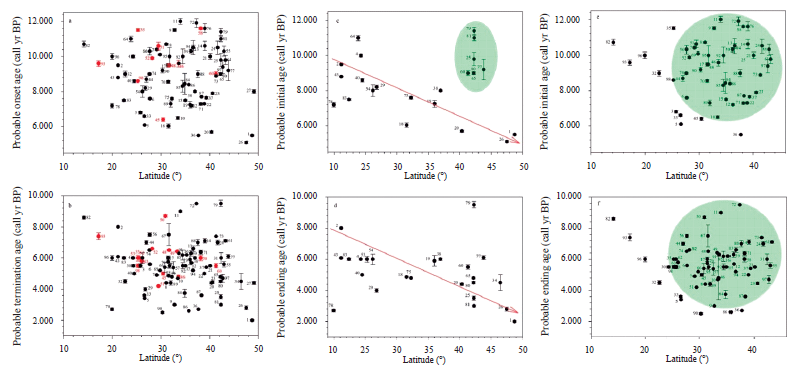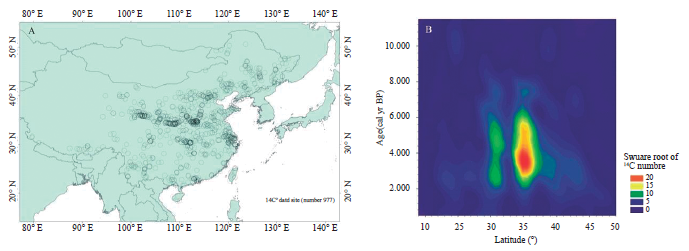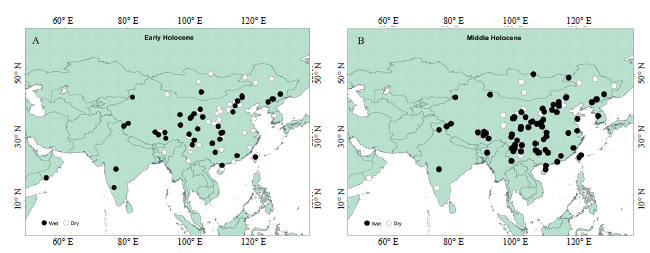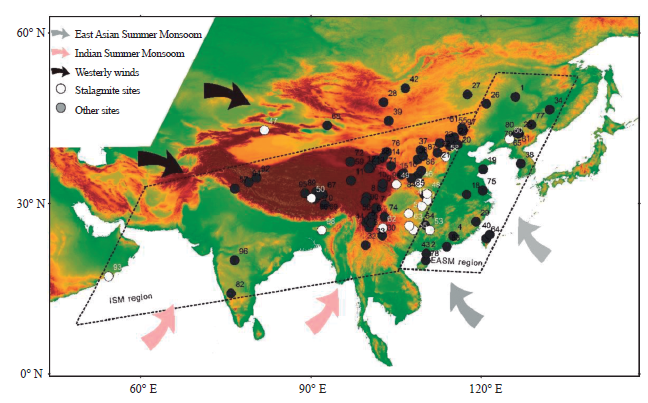Introduction
The impacts of global warming on the Asian monsoon region are not well understood and many controversies still remain (Ding et al., 2009; An et al., 2015; Yang et al., 2015). The Holocene Megathermal period has generally been considered as an analog for the current global warming (Renssen et al., 2012; Marcott et al., 2013; Yang et al., 2015) and may explain the shift of the monsoon rainfall boundary. In the East Asian monsoon region, Holocene climate changes have been investigated, supported by numerous high-resolution records, based on lake sediments (Zhou et al., 2016; Sheng et al., 2017), stalagmites (Berkelhammer et al., 2012; Dong et al., 2015; Bai et al., 2017), and several other terrestrial records (Zhao et al., 2013; Li et al., 2017). Furthermore, the spatial and temporal patterns of the HO are still extensively debated (An et al., 2000; Wu et al., 2011; Zhou et al., 2016).
An et al. (2000) synthesized a large number of paleoclimatic records and reported a southeastward shift of the East Asian summer monsoon maximum or a time-transgressive Holocene Optimum (HO), which refers to a relatively warm and wet period during the Holocene. In addition, the optimum growth period of peatland in the East Tibetan Plateau in likely consistent with the southward-declined Asian summer monsoon intensity (Xu et al., 2013). Furthermore, Zhou et al. (2016) reported an apparent time-transgressive onset of the HO from several paleoclimatic records in Eastern China. However, the S18O records of stalagmites in the East Asian monsoon region indicated an intricate trend of the HO. For example, the HO weakened before the summer monsoon in southern China, followed by northern China (Cai et al., 2010); moreover, no time-transgressive characteristic of the HO was found (Wu et al., 2011).
Previous studies found that the variability of Asian summer monsoon subsystems (i.e., the East Asian summer monsoon (EASM) and the Indian summer monsoon (ISM)) were likely asynchronous or more complicated during the Holocene than today (An et al., 2000; Li et al., 2014). A numerical simulation of the paleoclimate demonstrated that the Asian orography could lead to an asynchronous development of both the EASM and ISM during the earlier geological history (Tang et al., 2012). However, the nature of the HO with its high monsoon precipitation still remains unclear. Consequently, the spatial and temporal divergence of the Holocene monsoon precipitation and the underlying mechanisms require further investigation. This review presents a synthesis of the latest Holocene paleoclimatic records in Eastern Asia with a focus on the time-transgressive character, to explain the interaction between the EASM and the ISM during the HO.
Data sources and methods
After 2000 AD, scientists have studied Holocene Asian monsoon records with a variety of methods (An et al., 2000; Hong et al., 2000; Zhao et al., 2007; Zhao et al., 2011; Huang et al., 2013; Chen et al., 2015; Hillman et al., 2017). For this study, a total of 98 reconstructed paleoclimate records across East Asian was used (e.g., lake sediments, pollen assemblages, diatom records, mineral magnetism, grain size, geochemical, δ 13C, δ 18O, magnetic susceptibility, δ Dwax, speleothems δ18O and S13C, loess profile magnetic susceptibility, paleosol, peatland pollen, basal peat age, humification degree, loss on ignition, TOC, and grain size). 95 records were reported after 2000 AD. Each selected proxy is likely linked to the Asian summer monsoon rainfall variability and was dominated by various mechanisms. Chronologies of these records are controlled by 14C dates, OSL, 230Th dates, Pb/Cs, and varve counts. Most chronologies are based on more than five radiocarbon dates (see Supplementary Table S1). No standard boundary existed between the ISM and the EASM (e.g., Wang & LinHo, 2002; Wang et al., 2010; Rao et al., 2016). A recent study demonstrated that stalagmite δ 18O records reflect the history of the ISM rather than that of the EASM. Therefore, the ISM region of this paper consists mostly of stalagmite sites (Liu et al., 2015).
The paleoclimate records for 92 sites in East Asian monsoon region were evaluated, and the onset and termination time of the HO during the Holocene were identified. The pollen index is a widely used and available paleoclimatic indicator for vegetation and climate reconstructions (Liu, 1988; Zhao et al., 2009; Zhao and Yu, 2012). Liu (1988) demonstrated that the Holocene pollen stratigraphies suggest a tripartite division that includes a thermal mid-Holocene from the temperate forests of China. A previous study suggested that many processes other than climate change may be involved in the production of the δ 18O signal derived from speleothems (Dykoski et al., 2005). Moreover, the stalagmite δ 18O records from the EASM region has been debated (Liu et al., 2015; Liu et al., 2017) and the main trend of stalagmite δ 18O records from the East Asian monsoon region strongly represents the evolution of ISM (Liu et al., 2015). Consequently, fossil pollen records from 48 sites across East Asia were evaluated and synthesized to reconstruct vegetation and climate changes during the Holocene. Speleothems δ 18O records derived from 16 caves were also preliminarily identified for the ISM strength variation (Fig. 1). In addition, other proxies mentioned in the last paragraph were widely used to document the effects of the summer monsoon. For example, magnetic susceptibility is generally indicative of soil/loess boundaries in the Loess plateau (Guo et al., 2000).
Results and discussion
Time-transgressive characteristics of the HO in East Asian monsoon regions No obvious trends of the HO evolution were found in the East Asian monsoon region, and the onset and termination ages of speleothem sites are also generally consistency (Fig. 2 a, b). This partially supports that there is no time-transgressive pattern of the HO, which is derived from the comparisons of stalagmites δ 18O records from the East Asian monsoon region at different latitudes (Wu et al., 2011). Although, precipitation mainly originates from Asian summer monsoon, numerous studies have proved that the Asian summer monsoon system can also be divided into two subsystems: the EASM system and the ISM system which are largely independent and interact with each other (Ding and Chan, 2005; Li et al., 2014; Liu et al., 2015; Rao et al., 2016). Therefore, it is necessary to investigate both the spatial and temporal HO from separated Asian monsoon regions. Liu et al. (2014) reviewed Chinese Holocene records and reported that the traditional EASM proxy of moisture records were inconsistent with the stalagmite δ 18O records. The authors further proved that the stalagmite S18O records reflected the history of the ISM rather than that of the EASM. Furthermore, processes other than climate (e.g., kinetic fractionation, the mixing of water during residence in the vadose zone, dissolution-reprecipitation, and the degassing history) may affect the δ18O signal derived from speleothems (Dykoski et al., 2005). Furthermore, Rao et al. (2016) demonstrated that δ 18O paleo-records cannot be directly used as paleo-humidity indicators in the EASM region. These reports and the re-analysis in the current study suggest that the stalagmite δ 18O records might have numerous influencing factors, and more attention needs to be paid to clarify the indicative climate modes.

Figure 2 Onset and termination age (with error) of the HO in the East Asian monsoon region. The span space ranges from 12°N to 50°N and the age ranges from 12000 cal yr to 2000 cal yr BP. (a, b) shows all ages; (c, d) shows the ages in the EASM region; (e, f) show the ages of of the ISM region. The red dots in a and b reporesent speleothems oxygen isotopes; the red arrors in c and d indicate the general data trend; ages in green areas may be influnced by complex mechanisms.
To explore the evolution pattern of the HO, the initial and termination ages were divided into two regions: the EASM region (Fig. 2c, d) and the ISM region (Fig. 2e, f). In the EASM region, a strong relationship exists between latitude and both the initial (Zhou et al., 2016) and termination ages of the HO. The northeastern high regions form an exception and started about 4000 years earlier than the same latitude regions (Fig. 2 c,d). In the ISM region, no obvious connection was found between latitude and the initial and termination ages of the HO, and any variation might be affected by the Tibetan Plateau orography (Tang et al., 2012). However, the low-land sites of the south Tibetan Plateau clearly show an expansion and retreat northward of the HO. This is inconsistent with the timing of the peatland formation along the east Tibetan Plateau transect, which indicates a regression of humidity southward (Xu et al., 2013). Consequently, with regard to the time-transgressive initial and termination ages of the HO, both the EASM and ISM might simultaneously strengthen and regress during the early to middle Holocene; however, the regional topography and atmospheric circulation also can influence the humidity records.
The spatiotemporal character of Holocene demographic fluctuations
A total of 3851 radiocarbon dates from 977 archaeological sites were included in the utilized database, as shown in Fig. 3A (Wang et al., 2014). These radiocarbon dates were re-analyzed to investigate the characteristic of Holocene demographic fluctuations in the East Asian monsoon region. The shape of the summed probability distribution (Fig. 3B) suggests a boombust pattern in population size between 6000 to 2000 cal yrs BP and around latitude 35°N. With regard to the most archaeological sites located in the EASM region, and the major population expansion occurring when the HO regressed (Fig. 2d), it can be concluded that climate changes and technological development may have both shaped the boom history of Neolithic human demography (Wang et al., 2014).

Figure 3 A. Distribution of archaeological sites in China, contributing radiocarbon dates to the database (redrawn after Wang et al. (2014)); B. Spatiotemporal distribution of interpolated 14C age numbers (square root of 14C age numbers)
Patterns of humidity evolution during the early (12-8 ka) and middle (8-5 ka) Holocene
Two divided Holocene parts were chosen for this study: the early Holocene and the middle Holocene. These were compare the the arid central Asia (ACA) region and the monsoonal region (Fig. 4A, B). The dry/wet pattern in East Asia based on the latest Holocene humidity records showed that the wet condition in the monsoonal region and the relative dry condition in the ACA region during the early Holocene (Chen et al., 2008). During the middle Holocene, both the ACA region and the monsoonal region showed a wet or humid condition, which might indicate a maximum HO during this period where ISM would introduce water vapor to the ACA (Huang et al., 2015). Therefore, the enhanced summer monsoon could help the flourishing Neolithic human population in the region (Wang et al., 2014).

Figure 4 Spatial patterns of effective-moisture changes from arid central Asia and monsoonal Asia for two different periods of the Holocene (A. early Holocene: 12-8 ka BP; B. middle Holocene: 8-5 ka BP; sites are the same as in Fig. 1).
Conclusions and prospect
Based on 98 selected paleoclimatic records in East Asia (mostly in the Asian summer monsoon region), (1) a strong relationship between latitude and the initial and termination ages of the HO was found. This indicates that both the EASM and the ISM might simultaneously strengthen and regress during the early to middle Holocene; however, variations might be affected by the orography of the Tibetan Plateau. (2) Based on this relationship, predictions can be made for the initial and termination ages of the HO at different geographical locations. (3) In contrast to radiocarbon dates from archaeological sites, the results of this study suggest that the HO and technological development may have both shaped the boom history of the Neolithic human demography.
These results further suggest that additional studies are required with a further focus on the spatial and temporal patterns of Holocene humidity records and the influence of topography. This study improves the current understanding of the time-transgressive characteristics of the HO in East Asian monsoon regions.















